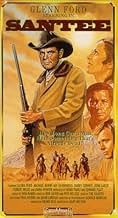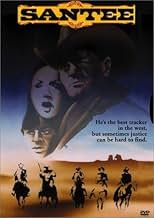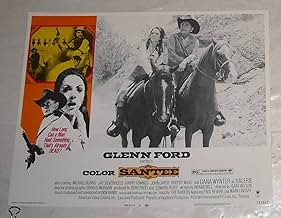AVALIAÇÃO DA IMDb
5,8/10
628
SUA AVALIAÇÃO
Adicionar um enredo no seu idiomaA bounty hunter takes in the son of a man he killed.A bounty hunter takes in the son of a man he killed.A bounty hunter takes in the son of a man he killed.
- Direção
- Roteiristas
- Artistas
Robert J. Wilke
- Deaks
- (as Robert Wilke)
- Direção
- Roteiristas
- Elenco e equipe completos
- Produção, bilheteria e muito mais no IMDbPro
Avaliações em destaque
Few people remember that SANTEE was one of the very first feature films (and almost definitely the first Western) shot on videotape. Noted character actor Ed Platt, famous for his role as "The Chief" in the TV series GET SMART, reportedly invested his own money in this film, intending to champion the concept of shooting movies economically on videotape.
The process used portable Philips (aka Norelco) video cameras and primitive Ampex 2" videotape recorders, which they powered via batteries while shooting on-location the desert and in and around California and Nevada. A 1973 issue of AMERICAN
CINEMATOGRAPHER covered the work done by director of photography Don Morgan and his crew, and went in-depth on the differences between shooting on film and shooting on video. Sadly, SANTEE was a flop in theaters, and Ed Platt lost his money and died less than a year after the movie was released.
Three decades later, innovative filmmakers like Robert Rodriguez and George Lucas are using digital video gear to shoot movies. Ed Platt was definitely ahead of his time on SANTEE; sadly, he never lived to see the technology get to the point where it would work.
The process used portable Philips (aka Norelco) video cameras and primitive Ampex 2" videotape recorders, which they powered via batteries while shooting on-location the desert and in and around California and Nevada. A 1973 issue of AMERICAN
CINEMATOGRAPHER covered the work done by director of photography Don Morgan and his crew, and went in-depth on the differences between shooting on film and shooting on video. Sadly, SANTEE was a flop in theaters, and Ed Platt lost his money and died less than a year after the movie was released.
Three decades later, innovative filmmakers like Robert Rodriguez and George Lucas are using digital video gear to shoot movies. Ed Platt was definitely ahead of his time on SANTEE; sadly, he never lived to see the technology get to the point where it would work.
Santee is directed by Gary Nelson and written by Brand Bell. It stars Glenn Ford, Michael Burns, Dana Wynter and Jay Silverheels. Music is scored by Don Rand and photography is by Donald Morgan. Plot finds Ford as seasoned bounty hunter Santee, who after killing the outlaw father of young Jody Deaks (Burns), takes him under his wing at his Three Arrows Ranch. With both of them nursing loses in their lives, they both come to be great for each other, but just as harmony is abundant at the ranch, news comes that the outlaw gang responsible for Santee's pain is back in town.
No country for empty pockets and a flat stomach.
Primarily shot on location in Santa Fe, New Mexico, Santee is notable for a couple of things. Firstly it was the last time that Western legend Ford would play a lead role in the genre, secondly is that it was filmed on video tape. Some debate exists as to if it was the first film to be shot that way, but certainly the research suggests it was definitely the first Western. Santee is a strange film in many ways, for sure as a film it's not a great lead role send off for Ford, but he is actually very good in it. The story is a good one from Bell, full of emotional worth and maintaining interest throughout, while there's plenty of action and blood shed within the plot. The dialogue, too, often has some intelligence about it. But it's so poorly put together it becomes a frustrating watching experience.
The video tape filming doesn't work, the colour is often dull and the night interiors are lifeless. While a couple of close ups appear to suddenly become pan and scan! Other problem comes with there being no truly great villain to underpin the destinies of Santee and Jody Deaks. The Banner (John Larch) gang exist, get a couple of small scenes, but that's about it until the bloody finale. The cast around Ford are OK, Wynter doesn't quite look right for a ranch gal lover, but makes a mark as a loyal wife and surrogate mother. Burns has the youthful naivety just right, but isn't helped by the screenplay having him become a killing man too quickly, and Silverheels turns in a good one as the wise ranch hand at Three Arrows. The film is very 70s in look and feel, something that can take you out of the period setting, more so with Rand's foot tapping music accompaniment. Bonus, though, on the music front, is the feature song in the picture, "Jody," that is song by Paul Revere and The Raiders, it's a beautiful ballad and carries with it the requisite emotional heft.
An enjoyable Western with one or two tricks up its sleeve, but the problems are evident and stop it from being a must see for anyone other than Western and Glenn Ford purists. 6/10
No country for empty pockets and a flat stomach.
Primarily shot on location in Santa Fe, New Mexico, Santee is notable for a couple of things. Firstly it was the last time that Western legend Ford would play a lead role in the genre, secondly is that it was filmed on video tape. Some debate exists as to if it was the first film to be shot that way, but certainly the research suggests it was definitely the first Western. Santee is a strange film in many ways, for sure as a film it's not a great lead role send off for Ford, but he is actually very good in it. The story is a good one from Bell, full of emotional worth and maintaining interest throughout, while there's plenty of action and blood shed within the plot. The dialogue, too, often has some intelligence about it. But it's so poorly put together it becomes a frustrating watching experience.
The video tape filming doesn't work, the colour is often dull and the night interiors are lifeless. While a couple of close ups appear to suddenly become pan and scan! Other problem comes with there being no truly great villain to underpin the destinies of Santee and Jody Deaks. The Banner (John Larch) gang exist, get a couple of small scenes, but that's about it until the bloody finale. The cast around Ford are OK, Wynter doesn't quite look right for a ranch gal lover, but makes a mark as a loyal wife and surrogate mother. Burns has the youthful naivety just right, but isn't helped by the screenplay having him become a killing man too quickly, and Silverheels turns in a good one as the wise ranch hand at Three Arrows. The film is very 70s in look and feel, something that can take you out of the period setting, more so with Rand's foot tapping music accompaniment. Bonus, though, on the music front, is the feature song in the picture, "Jody," that is song by Paul Revere and The Raiders, it's a beautiful ballad and carries with it the requisite emotional heft.
An enjoyable Western with one or two tricks up its sleeve, but the problems are evident and stop it from being a must see for anyone other than Western and Glenn Ford purists. 6/10
I spoke to Ed Platt in early 1974, not long before his death. If he was troubled by the financial failure of "Santee," he didn't show it; he was warm and unpretentious. We had a common interest in video production, which probably helped him open up. In any event, I didn't see "Santee" for more than 35 years; I must say, Ed's innovative use of video to film hurt the movie; and, as a relatively novice producer, Ed should have played it safe and stayed with film. The interior shots appear horribly lit, and the initial scenes are cluttered and almost tedious. However, after Glenn Ford shows up, the movie loosens up, and we get a pretty well written, expertly acted movie. The casting, particularly of Ford, Michael Burns, Harry Townes and Jay Silverheels is especially inspired. Dana Wynter seems an odd choice, especially since the reddish lighting makes her look Native American, and she can't completely disguise her British accent. However, Wynter's chemistry with Ford and Burns is downright terrific, and she dominates every scene.
"Santee" needs more fleshing out, and the money spent on the flashback could have been been spent building Ford's relationship with Burns. The ending comes too soon and too abruptly. Nonetheless, "Santee" is one of Ford's better westerns, certainly better than "A Time for Killing," "Day of the Evil Gun" and "The Last Challenge." As Ford's last starring western it is a flawed, if fitting tribute to one of the great cowboy actors.
I give "Santee" a "6".
"Santee" needs more fleshing out, and the money spent on the flashback could have been been spent building Ford's relationship with Burns. The ending comes too soon and too abruptly. Nonetheless, "Santee" is one of Ford's better westerns, certainly better than "A Time for Killing," "Day of the Evil Gun" and "The Last Challenge." As Ford's last starring western it is a flawed, if fitting tribute to one of the great cowboy actors.
I give "Santee" a "6".
Another movie from the Mill Creek 200 cult cinema box set.
Pretty good western about a bounty hunter who takes in the boy of the man he killed. Teaches him the ropes and becomes like a father to him.
I liked this, not to big on westerns but very well done. Glen Ford is great as Santee. All around good movie.
Pretty good western about a bounty hunter who takes in the boy of the man he killed. Teaches him the ropes and becomes like a father to him.
I liked this, not to big on westerns but very well done. Glen Ford is great as Santee. All around good movie.
Thoroughly mediocre Ford vehicle has him as the West's toughest bounty hunter (?!?). He lets the son of the guy he just killed follow him around, then eventually gives him a job. The son gives up his plans for revenge, opting to become a bounty hunter himself instead. Wynter is given a role that is thankless window dressing, and Silverheels is the only person in the movie who looks in shape for the West. Some good action, and it was good to see Silverheels in a movie again (though his part was fairly small), but bare plot goes on too long for its own good.
Você sabia?
- CuriosidadesIn 1972-73, Edward Platt ("The Chief" in Agente 86 (1965)) raised enough money to produce this film, which was one of the first independent color movies shot partially on videotape. It was actually the first western to use videotape on location. Platt saw the many advantages of using videotape rather than film, and his crew shot the production with portable TV cameras (Norelco PCP-70 NTSC analog television system and the Philips PC-70 studio color camera) along with the Ampex VR-3000 two-inch portable video tape recorder). Once completed, the images were transferred to 35mm film format for it's theatrical release.
- Versões alternativasThe UK video version was cut by 4 secs to remove a horse-fall.
- Trilhas sonorasJody
Music by Don Randi
Lyrics by Bob Silver & Pete Willcox
Performed by The Raiders, featuring Paul Revere & Mark Lindsay
Principais escolhas
Faça login para avaliar e ver a lista de recomendações personalizadas
- How long is Santee?Fornecido pela Alexa
Detalhes
- Data de lançamento
- País de origem
- Central de atendimento oficial
- Idioma
- Também conhecido como
- Santee
- Locações de filme
- Empresas de produção
- Consulte mais créditos da empresa na IMDbPro
Contribua para esta página
Sugerir uma alteração ou adicionar conteúdo ausente

Principal brecha
By what name was Santee - O Caçador de Recompensas (1973) officially released in India in English?
Responda


































